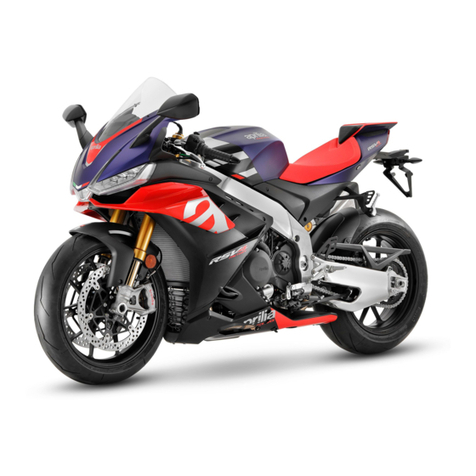
INDEX
GENERAL RULES....................................................................... 7
Foreword............................................................................... 8
Motorcycle care..................................................................... 8
Carbon monoxide.................................................................. 11
Fuel....................................................................................... 12
Hot components.................................................................... 12
Coolant.................................................................................. 13
Used engine oil and gearbox oil............................................ 13
Brake fluid............................................................................. 14
Battery hydrogen gas and electrolyte.................................... 14
Stand..................................................................................... 15
Reporting of defects that affect safety................................... 15
VEHICLE...................................................................................... 17
Arrangement of the main components...................................... 18
Dashboard................................................................................ 21
Digital instrument panel............................................................ 23
Light unit................................................................................... 24
Digital lcd display...................................................................... 25
Alarms................................................................................... 32
Mapping selection................................................................. 37
Control buttons...................................................................... 40
Advanced functions............................................................... 55
Ignition switch........................................................................ 78
Locking the steering wheel.................................................... 79
a-PRC setting buttons............................................................... 79
Horn button............................................................................... 80
Switch direction indicators........................................................ 81
High/low beam selector............................................................. 82
Passing button.......................................................................... 82
Daytime/night lights switch........................................................ 83
Start-up button.......................................................................... 84
Engine stop switch.................................................................... 84
Selector Cruise Control / AWC................................................. 85
Button PIT................................................................................. 88
System a-PRC (Aprilia Performance Ride Control).................. 89
Immobilizer system operation................................................ 109
The saddle................................................................................ 110
Identification.............................................................................. 113
USE.............................................................................................. 115
Checks...................................................................................... 116
Refuelling.................................................................................. 119
Rear shock absorbers adjustment............................................ 121
Rear shock absorbers setting................................................ 125
Front fork adjustment................................................................ 127
Front fork setting................................................................... 130
Steering shock absorber adjustment........................................ 133
Justering af greb til forbremse.................................................. 135
Clutch lever adjustment............................................................ 135
Running in................................................................................. 136
Starting up the engine............................................................... 137
Moving off / riding...................................................................... 139
Stopping the engine.................................................................. 144
Parking...................................................................................... 145
Catalytic silencer....................................................................... 146
Stand......................................................................................... 147
Suggestion to prevent theft....................................................... 148
Safe driving............................................................................... 148
Basic safety rules...................................................................... 150
MAINTENANCE........................................................................... 155
Foreword................................................................................... 156
Engine oil level check............................................................ 156
Engine oil top-up................................................................... 157
Engine oil change.................................................................. 158
Engine oil filter replacement.................................................. 158
Tyres......................................................................................... 158
Spark plug dismantlement........................................................ 160
5


































